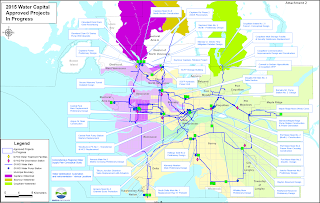The City of Langley's vision for its downtown is to build a vibrant, walkable core. One of the best examples of a newer building that follows this vision is The Muse. It is a mixed-use building with ground-level retail that abuts the sidewalk on Fraser Highway.
 |
| The Muse on Fraser Highway in Langley City |
Redevelopment projects that include retail space have been slow coming to Downtown Langley for a variety of reasons. Because of this, it seems that City Council has felt compelled to approve any new project, even if it doesn’t align with the vision contained in the Downtown Master Plan.
One of the new projects that is being built right now is the Tim Hortons at the corner of Douglas Crescent and 203rd Street. While many elements of the project will contribute to a walkable downtown core, some major elements do not.
The Downtown Master Plan states that projects should be designed at a human scale. The Tim Hortons building is designed at a human scale, and the main entrance fronts Douglas Crescents. One of the major issues with the project is that the City of Langley allowed the construction of a highway-sized sign that is larger than the building itself. Even Surrey doesn’t allow signs like this as they are ugly and degrade the public realm.
 |
| New Tim Hortons at the corner of Douglas Crescent and 203rd Street. Select image to enlarge. |
The Master Plans also requires that commercial redevelopment incorporate decorative sidewalks, appropriate street furniture and street trees. I do not see all of this in the Tim Hortons project, though it does include scrubs and a metal sculpture thing which attempt to hide the drive thru and new parking.
One the topic of parking, the Downtown Langley Master Plan recommends that new buildings constructed in the Langley Mall site use the existing, underutilized parking. The Tim Hortons project includes even more parking. For new parking, the Master Plan says that the City should "restrict off-street parking between the street and the building with any off-street parking required in underground parking, structured parking (or cash-in-lieu contribution), or surface parking behind the building that is unobtrusive and screened from public view." The new Tim Hortons parking fronts Douglas Crescent.
One of the best things that can be done to bring life to a sidewalk is with outdoor seating for cafes and restaurants. This is encouraged in the Downtown Master Plan. Sadly, the Tim Hortons project actually tries to shield the building from Douglas Crescent with a berm and scrubs.
 |
| New Tim Hortons looking from Douglas Crescent. Select image to enlarge. |
With a few tweaks to the Tim Hortons plan, many of the issues I’ve mentions could have been avoided without impacting the viability of the project.
I have been highlighting the new Tim Hortons project lately, but the older Starbuck redevelopment at Valley Centre Mall, with its drive thru and blank wall along Fraser Highway, shares many similarities.
Sadly, each project that the City approves which doesn’t line up with the vision of the Downtown Plan, erodes the vision of building a vibrant, walkable downtown core.
If citizens in Metro Vancouver vote “Yes” in the upcoming transit plebiscite, it will be a game changer for Langley City’s Downtown. Instead of incremental, mostly auto-oriented commercial development, there will a stronger push by the property owners and developers to build new projects downtown. City Council and staff will still need to make sure that Downtown Langley develops according to the vision laid out in the Downtown Langley Master Plan. Hopefully with more consistency than they have done to date.




















